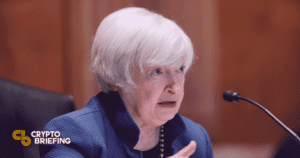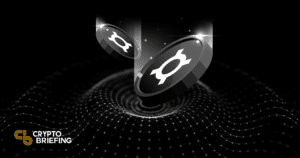
Key Takeaways
- U.S. legislators are supposedly preparing a costs to position a two-year restriction on particular stablecoins.
- The House Stablecoin Bill would target "endogenously collateralized stablecoins."
- The brand-new expense might affect decentralized stablecoins like FRAX, depending upon the phrasing utilized in the last draft.
The legislation can be found in action to the May collapse of the algorithmically-backed TerraUSD stablecoin.
U.S. Proposes Stablecoin Regulation
House legislators are taking an action towards controling stablecoins.
A brand-new costs is looking for to put a two-year restriction on "endogenously collateralized stablecoins," according to a draft acquired by Bloomberg late Tuesday.
The House Stablecoin Bill would make it prohibited to release or develop brand-new stablecoins that imitate the performance and functions of TerraUSD-- an algorithmically-backed stablecoin that infamously lost its dollar peg in May, eliminating billions of dollars in worth as it irrecoverably crashed to no. More particularly, the expense would restrict any stablecoin marketed as having the ability to be transformed, redeemed, or bought for a repaired quantity of financial worth, in addition to any that relies entirely on the worth of another digital property from the very same developer to keep a repaired cost.
In addition to the moratorium on algorithmically-backed stablecoins, the expense draft likewise mandates a research study on Terra-like tokens from the Treasury in assessment with the Federal Reserve, the Office of the Comptroller of the Currency (OCC), the Federal Deposit Insurance Corp., and the Securities and Exchange Commission.
While the costs mostly concentrates on limiting "unbacked" stablecoins from going into flow to secure customers, it likewise consists of assistance on how fiat-pegged properties need to be managed more usually. The expense would enable both banks and non-banks to release stablecoins. Bank providers would require approval from federal regulators such as the OCC. When it comes to non-bank companies, the legislation directs the Federal Reserve to develop a procedure for making application choices.
The House Stablecoin Bill is the very first piece of legislation directed at managing the growing stablecoin market. According to information from CoinGecko, the overall stablecoin market capitalization sits at over $153 billion. The marketplace size has actually increased by around 600% as the wider crypto environment has actually grown over the previous 2 years.
While the bulk of stablecoins in flow are backed by dollar or dollar equivalents, lots of dollar-pegged tokens utilize unique techniques to keep their worth. The expense is still being prepared, numerous crypto users are stressed that its phrasing might link numerous genuine stablecoin jobs in its two-year restriction.
Which Stablecoins Could Be Affected?
Although the costs draft's phrasing is still subject to alter, the existing variation offers some hints regarding the instructions regulators mean to take. The expression "endogenously collateralized stablecoins" is broad and might describe any token backed or partly backed by other tokens from the very same provider.
TerraUSD, which was entirely collateralized by Terra's native token LUNA, would probably deal with a two-year restriction if it were still working today. For procedures developing dollar-pegged possessions utilizing a mix of tokens that are both endogenous (produced by the exact same company) and exogenous (provided by other celebrations), the expense is less clear.
On the one hand, previous stopped working stablecoin jobs such as Iron Finance do not always fit the meaning of being entirely collateralized by endogenous tokens. The procedure utilized a preliminary ratio of 75% USDC and 25% TITAN tokens to mint its IRON stablecoin. As history showed, when IRON crashed to no in June 2021, this kind of collateralization approach still presents a considerable danger to financiers.
Other procedures such as Frax Finance have up until now effectively used a blended collateralization approach. Frax, an abbreviation of "fractional-algorithmic," utilizes a variable ratio of USDC and its free-floating Frax Shares token to mint and collateralize its dollar-pegged FRAX. This approach of collateralization appears far more resistant than previous jobs such as TerraUSD or Iron Finance. Whether the brand-new stablecoin costs will acknowledge this distinction stays to be seen.
Another issue relating to the brand-new expense is how it may impact MakerDAO's DAI stablecoin. Unlike IRON and FRAX, DAI is entirely collateralized by exogenous possessions, mostly USDC and ETH Due to the fact that of this, the costs's restriction should not link DAI. Like all other non-bank stablecoin providers, if the brand-new expense is passed into law, the Maker procedure will likely require to sign up with U.S. regulators to continue serving users in the U.S.
As the U.S. federal government's very first venture into stablecoin legislation, the costs draft appears relatively conservative. In line with Treasury Secretary Janet Yellen's previous remarks, regulators are aiming to stablecoin companies more in line with standard financing. For many stablecoin providers, this should not be an issue. As constantly, the devil is in the information, so the expense's last variation will require to be launched prior to its possible effect ends up being clear.
Disclosure: At the time of composing this piece, the author owned ETH and numerous other cryptocurrencies.
The info on or accessed through this site is acquired from independent sources our company believe to be precise and trustworthy, however Decentral Media, Inc. makes no representation or service warranty regarding the timeliness, efficiency, or precision of any info on or accessed through this site. Decentral Media, Inc. is not a financial investment consultant. We do not provide customized financial investment suggestions or other monetary guidance. The info on this site undergoes alter without notification. Some or all of the details on this site might end up being out-of-date, or it might be or end up being insufficient or unreliable. We may, however are not obliged to, upgrade any out-of-date, insufficient, or incorrect info.
You must never ever make a financial investment choice on an ICO, IEO, or other financial investment based upon the details on this site, and you must never ever analyze or otherwise depend on any of the info on this site as financial investment recommendations. We highly suggest that you speak with a certified financial investment consultant or other competent monetary expert if you are looking for financial investment recommendations on an ICO, IEO, or other financial investment. We do decline settlement in any kind for evaluating or reporting on any ICO, IEO, cryptocurrency, currency, tokenized sales, securities, or products.
Yellen Echoes Stablecoin Warning Citing UST Crash
U.S. Treasury Secretary Janet Yellen has actually contacted Congress to pass stablecoin legislation, referencing UST's current depeg occasion. Yellen Highlights Stablecoin Risks Stablecoins are dealing with increased examination from the U.S. ...

A Week of Terra: the Story of Do Kwon and His Black Swan Wipeout
Terra's implosion will be kept in mind as one of the most significant minutes in crypto history. Chris Williams informs the story of the blockchain and its questionable leader, Do Kwon. Purchasing the ...

DeFi Project Spotlight: Frax Finance, a Sweet Spot for Stablecoins
Frax Finance is a decentralized procedure that can be considered a totally self-governing, on-chain reserve bank releasing and managing the financial policy of a fractional-algorithmic stablecoin called FRAX ...

Read More https://bitcofun.com/could-the-new-house-stablecoin-bill-kill-frax-and-dai/?feed_id=47551&_unique_id=63603d0784eea

No comments:
Post a Comment